Original title:Original title:
Original author: Breeze, Beep News
TL;DR
first level title
1. The Aptos ecosystem is rapidly expanding, and the project is highly original and of good quality.
2. The wallet experience in the Aptos and Sui ecology is better than most current wallets, and has the feature of placing functions directly on the front end of the wallet.
3. Sui's technical strength may lead all new public chains.
4. The modularization attempts of the chain, such as Celestia and Fuel, not only achieve expansion, but also bring imagination to the modularization layer and the composability between the modularization layers.
5. EVM compatibility is another attempt direction of the new public chain. Scroll is the Ethereum Rollup that implements the EVM equivalent. Mikomeda provides EVM-compatible functions for non-EVM-compatible chains such as Cardano and Algorand.
The new public chain has become a new market hotspot, which can be seen from two dimensions. One is the search index. The WeChat index shows that the search volume of Aptos and Linera has increased significantly since July.
The second is primary market investment data. Aptos completed 2 rounds of financing with a total of 350 million US dollars within 4 months. Sui's developer, Mysten Labs, is seeking at least $200 million in Series B funding. Linera announced the completion of a $6 million seed round of financing. These are all recent events.
These signs make us re-examine the new public chain track. As Beep News said in the article "30 New Public Chains", new Meta public chains, modular public chains, privacy public chains, and public chains that focus on compatibility are the seed players on this track.
In this article, Beep News will take stock of nine new public chain ecosystems including Aptos, Sui, Linera, Aleo, Celestria, Fuel, Scroll, Espresso, and Milkomeda. Let's explore these ecological projects together!
first level title
Aptos ecology
Aptos is the most concerned among the new public chains of the Meta series that have been announced. This chain was born in February this year, and the team comes from Meta's Diem project.
Aptos' vision is to improve the security and scalability of public chains based on Diem's technology. According to the data, the TPS of Aptos can reach more than 10,000. At present, the test network processes about 15 transactions per second. The transactions on the testnet are far from saturated. During the use of Beep News, we also found that the testnet is very smooth to use, and transactions can be confirmed within a few seconds.
At present, Aptos is the fastest progressing among all Meta-system new public chains. From the perspective of financing, Aptos completed two rounds of financing in March and July this year, with a total financing amount of 350 million US dollars, the highest among the new public chains of the Meta series.
The ecology of Aptos is also improving rapidly. The team tweeted on June 29 that there were already over 100 projects under construction in the ecology. According to the statistics of Beep News, there are 44 Aptos ecological projects, and the track covers DeFi, NFT, wallet, infrastructure, Web3 and other fields.
From the perspective of ecological characteristics, the projects on the Aptos testnet are of high originality and high quality, including AMM Liquidswap, NFT market Topaz, domain name project names.aptos, wallets Martian and Fewcha Wallet, lending platform Vial Protocol, etc.
Aptos native wallet can be said to be better than most existing wallets in terms of user experience. These native wallets have the feature of putting functionality directly into the wallet interface. Both Martian and Fewcha support receiving test coins and displaying NFT on the wallet side. Fewcha will implement swap directly on the wallet side in the future.
However, there are also a large number of projects in the Aptos ecosystem that have not yet been launched. In addition, the overall quality of NFT projects is low, and the application scenarios seem to be dominated by PFP speculation.
There are also many DAPPs deployed in multiple chains on Aptos, among which DAPPs that have been built on Solana are the main ones. This type of DAPP may be deployed to a high-performance new public chain as a development strategy.

1.Liquidswap
https://liquidswap.com/#/
secondary title
To use Liquidswap, you need to install the MultiMask wallet first, you can follow https://mirror.xyz/killthewolf.eth/-zkeICbbJJzweOTRSt001Kujud7g_-Duk1bGPKa16EY.
2.Topaz
https://www.topaz.so/
Aptos' native NFT marketplace. Currently in the testnet stage, there are not many NFTs. The NFT creation function will be supported in the future.
3.names.aptos
https://www.aptosnames.com/
Aptos native domain name project. Currently in the testnet stage, you can experience buying .aptos domain names with test tokens. Data is reset weekly.
4.Martian
https://martianwallet.xyz/
Aptos native wallet. It is one of the two most frequently used wallets on Aptos.
5.Fewcha Wallet
https://fewcha.app/
Aptos native wallet. It is another wallet that is used most frequently. In the future, it will support swap directly on the wallet side.
6.Vial Protocol
https://www.vial.fi/app
Aptos native lending platform. Currently in the testnet stage.
7.Dialect
https://www.dialect.to/
secondary title
Smart communication protocol. Support DAPP notifications and chat between wallets. Currently deployed to Solana. Notifications and messages will be displayed in the inbox, and you can also send (encrypted) messages to addresses and tweets through the inbox. The protocol itself is relatively light, and it should be possible to embed functions into DAPP through code.
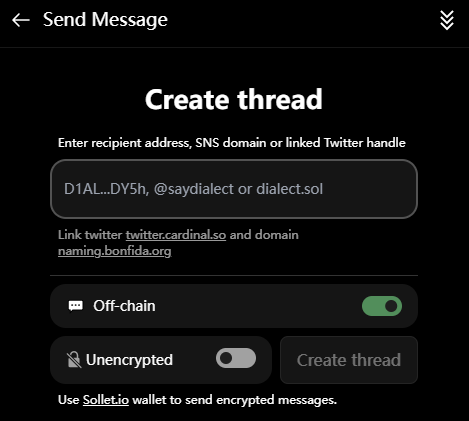
8.Hippo Labs
https://hippo.space/
The aggregation layer on Aptos does more complicated things, including transaction aggregation (access to the optimal pricing and loan interest rates of multiple DEXs and currency markets), developer tools, wallet adapters, etc. The function is not available yet.
9.Paymagic
https://www.paymagic.xyz/
Supports bulk transfer of tokens/NFTs, creation of tokens/NFT airdrops, setting attribution and streaming payments, powered by Safe.
10.Seam Money
https://www.seam.money/app
Stable currency multi-chain distributed income solution. Deployed on Celo and Aptos. Feature is currently unavailable.
11.Aptos.Systems
https://www.aptos.systems/
first level title
Sui ecology
Sui ecology
Judging from the official website documents, Sui's technical capabilities should not be weaker than Aptos. Aptos currently shows a good "marketing promotion" ability, and Sui emphasizes technical implementation in official documents. This team should have relatively strong technical capabilities.
The development team behind Sui is Mysten Labs. At present, the biggest technical advantage of the new public chains - the open source code library of the Move language is mainly managed by this team. Many of the founding team members have participated in Meta's Diem (stable currency) and Novi (wallet) projects.
Among them, CEO Evan Chang is the former director of research and development of Novi. CTO Sam Blackshear is the former chief engineer of Novi. Chief scientist George Danezis is the original Meta Research Scientist. The lineup can be said to be very strong.
Sui's official documents also reflect the rigor and meticulousness of these technicians. Every item in the document is clearly written, which can be said to be better than most blockchain project white papers.
However, Sui's ecological progress is relatively slow, and the current ecology is relatively poor, and the ecological project does not reflect the team's technical capabilities well. There are 5 ecological projects collected by Beep News, namely wallet, browser, 2 games, and Web3 workplace metaverse.
Sui hopes to achieve better applications in the four fields of games, DeFi, business, and social networking. Judging from the current ecological progress, Sui's development focus is indeed biased towards games and Web3. In addition, applications in the Solana ecosystem will also be deployed to Sui.
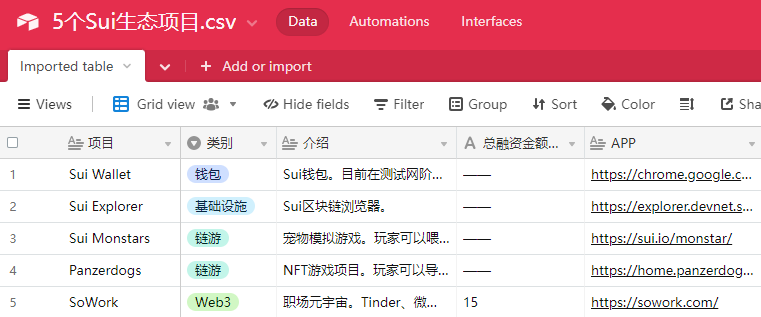
1.Sui Wallet
https://chrome.google.com/webstore/detail/sui-wallet/opcgpfmipidbgpenhmajoajpbobppdil
Sui native wallet. Currently in the testnet stage. Test tokens need to be collected at https://discord.com/invite/sui devnet-faucet. Currently Sui Wallet supports SUI sending and NFT display. In the future, it will support trading tokens directly on the wallet interface and earning income through pledge.
2.Sui Explorer
https://explorer.devnet.sui.io/
Sui blockchain explorer.
3.Sui Monstars
https://sui.io/monstar/
pet simulation game. Players can feed and dress up pets, decorate the farm, and improve the level of pets and farms through games and interactions. Pets, farms, and accessories are all NFTs. Currently unplayable.
4.Panzerdogs
https://home.panzerdogs.io/
This is an NFT P2E game developed by a game studio in the Netherlands, and the game has been built into the Solana ecosystem. One of the special points in the game is that the player's NFT (such as the NFT on Ethereum) can be "mapped" to Sui through SuiEco and used as an avatar in the game. These avatars team up for tank battles.
5.SoWork
https://sowork.com/
secondary title
SoWork currently supports two functions: one is to reward employees with achievement NFT, and NFT can be based on performance, value, and event-driven. NFT can be gifted, bought and sold, and displayed. The second is that you can create and cast custom NFTs through Mapmaker, and at the same time import NFTs into the workplace metaverse. The team emphasizes the performance of the chain, minting and importing can be completed almost simultaneously.
first level title
Linera: Bringing Web2 performance, especially linear scaling, to Web3
Linera is the slowest of the three Meta-system new public chains. Whether it is the official website or Twitter, there are relatively few reference information.
What is known so far is that the goal of Linera is to bring the performance of Web2, especially "linear scaling" to Web3. Most of our existing blockchains adopt a "sequential" execution model that allows accounts and smart contracts to interact arbitrarily in a series of transactions, but prevents "linear scaling".
In Linera's linear model, operations of different accounts run concurrently in different execution threads. It can be understood that the existing blockchain is a series circuit, and Linera should be made into a parallel circuit. In the "parallel" case, scaling can be achieved by adding new processing units to each validator.
Additionally, Mathieu Baudet, founder of Linera, was involved in creating the Diem blockchain. During the Meta period, he had a strong interest in FastPay and the Zef protocol. These 2 protocols speed up transactions by removing the mempool and reducing interactions between validators. Linera said it will carry forward these two agreements.
Linera completed a $6 million seed round of financing in June this year, with investors including a16z and others. As for ecological development, Beep News has yet to find information about project deployment to Linera.
first level title
Aleo: Privacy meets programmability
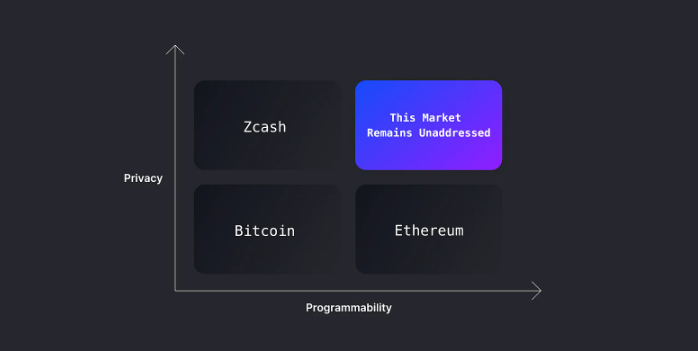
Learn about the ecological development of 9 new public chains in one article
Aleo solves this problem by recursively proving Zexe with zero knowledge. The overall structure is to put the calculation execution offline, and then generate an online transaction that can prove the calculation is correct without disclosing the details of the calculation. The transaction can be verified by anyone in a very short time. Thereby achieving privacy, programmability, and high TPS. The test network TPS is said to be between 10,000-20,000.
Aleo is actually an old project. The team launched Zexe first, and then started developing Aleo in 2020. Aleo can be seen as an implementation of Zexe. The platform also provides developers with the Leo programming language that is more friendly to zero-knowledge proof DAPP.
Aleo will complete Series A and B financing of US$28 million and US$200 million in April 2021 and February 2022, respectively. Investors include SoftBank, Tiger Global Management, a16z, Placeholder, Coinbase Ventures, Galaxy Digital, Polychain Capital, etc. The three co-founders of Aleo have worked for Google, IBM, ConsenSys, Gnosis, etc.
On August 2, Aleo launched Testnet 3, which means that it is one step closer to the mainnet launch. Testnet 3 will be divided into 3 stages, which will be carried out in August, September, and October respectively. Each stage will provide "Aleo Points" rewards, which are suitable for developers to participate. The total amount of Aleo points is 1 billion, and there are more distributions for early supporters.
In terms of ecological progress, Beep News did not find information on the deployment of the Aleo ecological project.
first level title
Celestia: the idea of modularization of the chain
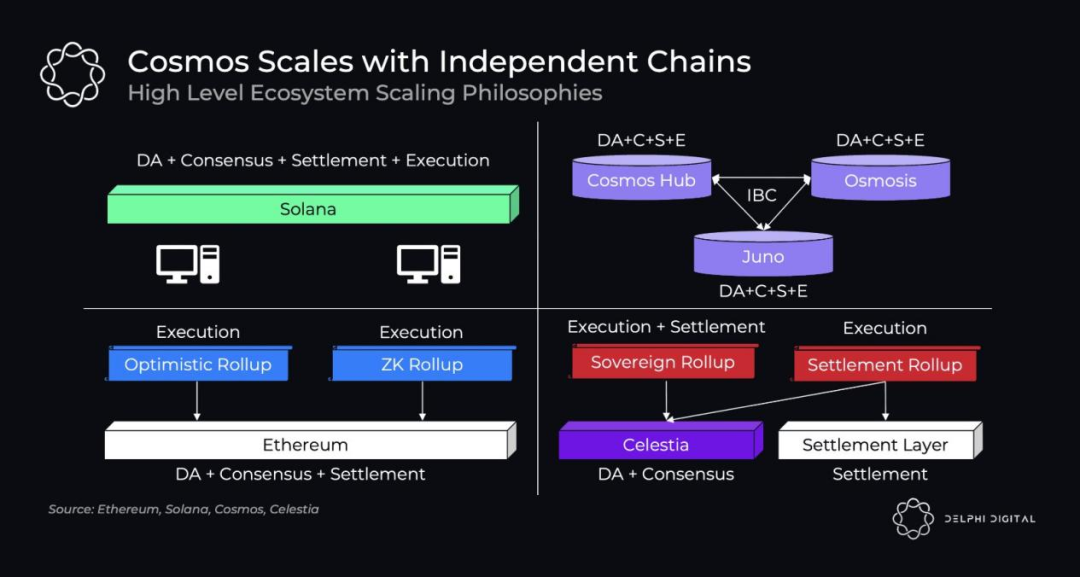
Learn about the ecological development of 9 new public chains in one article
Celestia abstracts itself as a layer dedicated to data availability. It does not consider the issue of transaction validity. Whether the transaction is valid, transaction execution and settlement are all handled by rollup or other settlement layers superimposed on it.
The advantage of this is that rollup can share Celestia's consensus and security. As long as Celestia's data history remains unchanged, rollups running the same validity rules will compute the same state, which brings security.
Rollup also does not need to design a consensus and token incentive mechanism, and does not need to rack its brains to persuade nodes to join in order to maintain network operation and improve decentralization. Rollup can simply exist as a lightweight layer, fully performing trade execution and settlement.
The editor believes that it may also be possible to use a data validity layer such as Celestia as a supplementary layer of L1 (such as Ethereum) with an independent consensus mechanism.
Celestia is currently in the testnet stage. Beep News also failed to find Celestia's ecological deployment information.
first level title
Fuel: Modular Execution Layer
Fuel positions itself as a modular execution layer. Fuel sees a "modular execution layer" as "a verifiable computing system designed for a modular blockchain stack." It can be understood as helping other layers or chains to prove fraud and validity, and data availability depends on modular data layers such as Celestia.
Fuel achieves high performance through 2 points. One is to implement parallel execution of transactions based on the UTXO model, so as to provide more calculations, state access, and transaction throughput than single-threaded. The second is based on FuelVM (Fuel Virtual Machine).
In terms of ecological progress, Fuel officially only mentioned SwaySwap.
SwaySwap
https://fuellabs.github.io/swayswap/
Fuel's native AMM. Currently a demo app on the developer network. You will be asked to create a wallet and receive test coins before using it. There is no need to download Google extensions to create a wallet, and the process is completely seamless. AMM currently supports swap and pool functions. The experience is particularly silky, the gas is low, and the transaction is confirmed quickly.
first level title
Scroll: Ethereum zkEVM Rollup
Scroll is not a chain in the strict sense, but Rollup of Ethereum. But its zkEVM is more worthy of attention.
Scroll's zkEVM can achieve EVM equivalent. Developers only need to modify a small amount of code to migrate DAPP on Ethereum to Rollup. At present, in addition to Scroll, there are Polygon Hermez and zkSync that have done a good job in zkEVM equivalent.
Scroll should be capable of technical realization of the project. Co-founder Ye Zhang has been working on zero-knowledge proofs. Another co-founder, Heichen Shen, studied in Tsinghua Yaoban as an undergraduate, and his doctoral research direction is biased towards the underlying system.
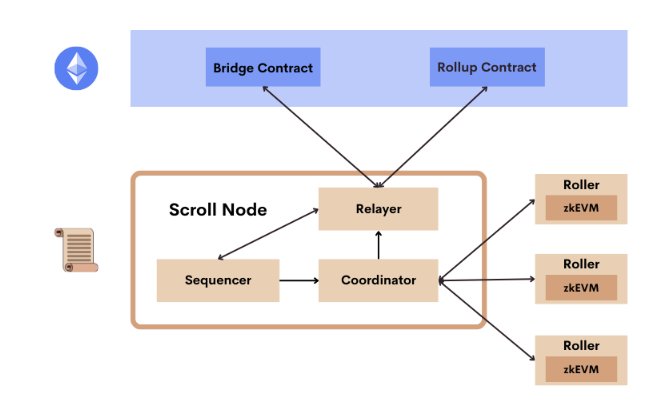
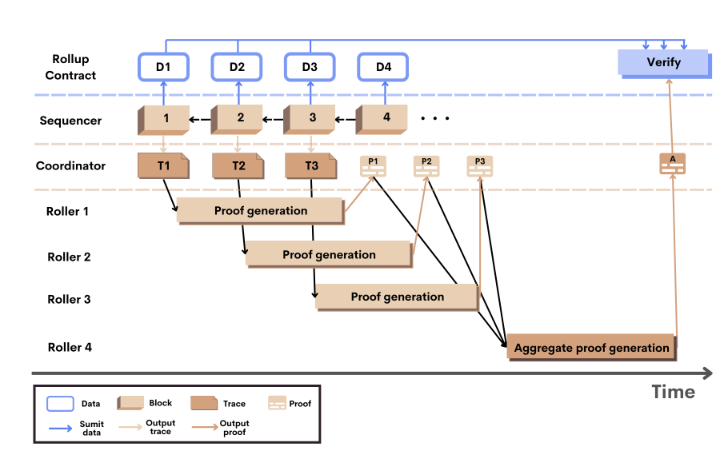
Learn about the ecological development of 9 new public chains in one article
In the design of Scroll, the Sequencer retrieves a batch of transactions from the Rollup memory pool every once in a while and executes them to generate L2 blocks. On the one hand, the Sequencer sends the blocks to the Coordinator, and the Coordinator randomly selects a Roller to generate validity proofs for each block, and the validity proofs of a certain number of blocks will be aggregated to form a single proof.
On the other hand, Sequencer submits data to the Rollup contract on Ethereum through Relayer to ensure data availability. The Rollup contract verifies the aggregation proof on this basis. In addition, there is a bridge contract between Ethereum and Rollup, and the two-way transmission of assets and messages is carried out through the Relayer.
It can be seen from the architecture that the special design of Scroll lies in Roller. The verification work is outsourced to the Roller community, and the Roller community can develop into a decentralized verification network. Roller expects to increase computing power through GPUs, FPGAs, and ASICs. But Scroll also faces the technical difficulty of zero-knowledge proof.
Considering the centralization risk of Rollup's Sequencer, Scroll will also implement a decentralized Sequencer in the future. In addition, Scroll is also working with Flashbots to explore options for reducing MEV.
In terms of financing, Scroll completed a US$30 million Series A round of financing in April this year, with investors including Polychian Capital and others. In terms of ecological progress, the deployment of ecological projects is expected to start from the alpha test network.
first level title
Espresso: Configurable Asset Privacy
Espresso uses Proof of Stake + ZK Rollup. One of its special features is configurable asset privacy.
Espresso launched a smart contract application called Configurable Asset Privacy for Ethereum (CAPE). Asset creators can customize who can see the ownership and movement of their assets, and can also set hidden asset data information, including asset senders, receivers, asset quantities, and types. CAPE can run on all EVM blockchains.
In addition, Espresso is also experimenting with privacy credentials. However, in terms of the specific implementation of high-performance and privacy technologies, the editor has not seen too many clear official introductions and explanations.
In terms of ecological progress, since it is still in the early stage, Espresso currently has no other applications except CAPE, and the deployment of ecological projects has not yet started.
first level title
Milkomeda: Provides EVM compatibility for non-EVM compliant chains
Milkomeda is essentially an EVM chain/layer that provides EVM compatibility for non-EVM compliant chains.
At present, Milkomeda has released Milkomeda C1 to provide EVM compatibility for Cardano. Milkomeda C1 is equivalent to an intermediary, and the assets on Cardano are converted into encapsulated assets through Milkomeda C1, such as ADA is converted into MikeADA. Encapsulated assets can participate in the Ethereum DeFi ecosystem, thereby expanding application scenarios.
In addition to Cardano, Milkomeda has also released Milkomeda A1 Rollup on the Algorand public testnet. The Solana ecosystem will also be supported in the future.
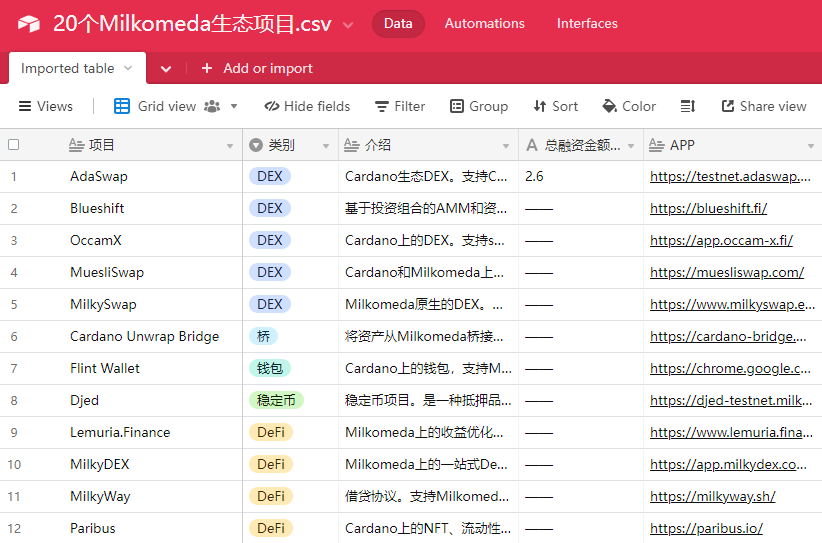
Learn about the ecological development of 9 new public chains in one article
https://testnet.adaswap.app/swap
https://blueshift.fi/
https://app.occam-x.fi/
https://muesliswap.com/
https://www.milkyswap.exchange/
There are 5 native DEXs: Ada Swap, Blueshift, OccamX, MuesliSwap, MilkySwap
https://cardano-bridge.milkomeda.com/bridge
In terms of cross-chain bridges, Cardano Unwrap Bridge supports the unwrap of assets back to Cardano, which is said to be relatively fast and easy to operate. In addition, the general-purpose cross-chain bridges Celer, Multichain, and Connext also support Milkomeda.
https://chrome.google.com/webstore/detail/flint-wallet/hnhobjmcibchnmglfbldbfabcgaknlkj?hl=en
The wallet is mainly Flint Wallet
Non-DEX DeFi protocols mainly include:
https://www.lemuria.finance/
Lemuria.Finance, Yield Optimizer
MilkyDEX, a one-stop DeFi store on Milkomeda, https://app.milkydex.com/swap
https://milkyway.sh/
MilkyWay, lending protocol